Balenciaga
See it »
These collections succeeded for reasons that go to the heart of what makes fashion feel alive and contemporary.
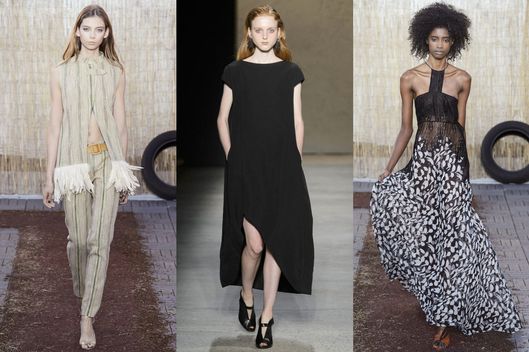

Peter Copping had a good idea for his second Oscar de la Renta show: He skipped the archives and went straight to de la Renta’s inspiration, his love for Spain. In his spring collection, Narciso Rodriguez liked volumes and fabrics that convey a looseness in attitude. The French designer Sophie Theallet completely threw caution to the wind and staged a roof-top show, with Senegalese drummers. For Coach, Stuart Vevers sought to fuse American prairie and punk.
Which of these designers do you think were successful?
Only Theallet and Rodriguez, and for reasons that go to the heart of what makes fashion feel alive and contemporary.
Let’s start with Vevers, because his problem is the easiest to see. In a specially built glass box near the High Line, with prairie grasses and flowers jammed into the sandy turf by the runway, Vevers opened with cute dresses in a patchwork of floral prints on a black background. They were mixed with biker vests and military jackets, and the models carried the latest Coach bags, some plastered with tiny leather flowers.
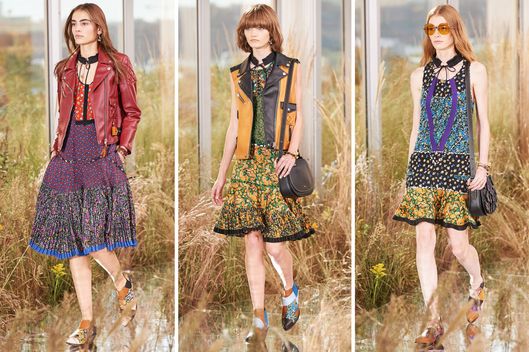
So far, so good. Vevers didn’t use real calico, but doubtless he looked at the humble prints, and I’ve been wondering why they haven’t inspired someone. But that’s as good as the Coach show got. Vevers simply added more variations of the ranch/biker theme as the runway turned into a merchandising platform.
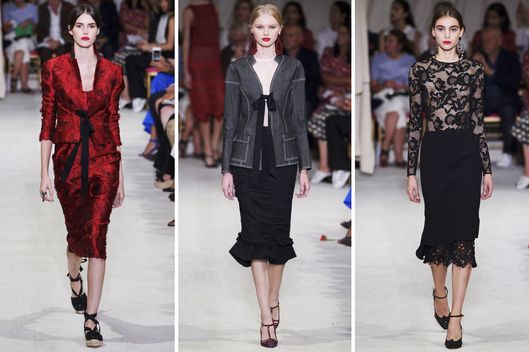
When I visited Copping in his Oscar de la Renta studio last week, I was excited by his thought process. He and some of his assistants spent hours researching materials at the Hispanic Society. And I thought entering Oscar’s world through his primary inspiration — de la Renta spent his younger years working, and becoming a dandy, in Madrid — was a smart idea. It would allow Copping more freedom to interpret the other designer’s style.
But the collection felt like so many disparate parts struggling to assert themselves, with none really succeeding. There were some lovely elements — spare black lace cocktail dresses, crocheted knits, a black-rinsed denim jacket with a notched collar and a ribbon closure, worn over a lace tank and stretch pique skirt. But the collection was seriously short of day clothes, or, to be more accurate, it lacked clear direction on that score. At his debut, Copping offered some fresh takes on Oscar’s suits, lightening them up. This time, the opening number was a dark-red floral pencil dress with a matching jacket, closed again by ribbons. Apart from the Spanish moodiness of the red-and-black floral jacquard (and the model’s espadrilles), it didn’t evoke the style of Oscar de la Renta. And Copping should ditch the ribbons. They’re prissy, and this brand, while it might be feminine and romantic, is not prissy.
A more fundamental flaw in the collection was that many of the styles are not new. They’re eye-catching, yes, but at second glance, you realize they’ve been around for a while — in one designer’s collection or another. And while in theory it makes sense to lighten up some of Oscar’s embroideries and uptown shapes, it’s not enough to just to whittle them down and add a ribbon. You need a harder, more self-critical measure of design. Otherwise, all you’re doing is taking the punch out of a zesty brand.
If Vevers and Copping illustrate the dangers of being too conservative, there was a restlessness and confidence in the collections of Rodriguez and Theallet that demanded attention.
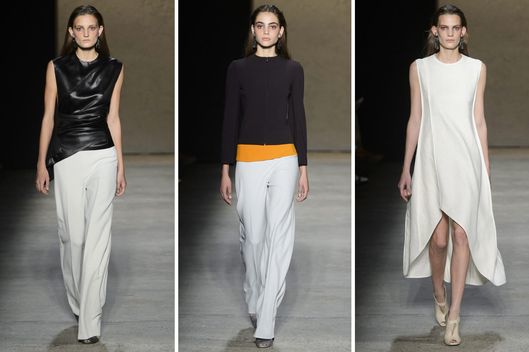
By contrast, Rodriguez swings for the fences. “There is no one better,” the chief merchant of a major store said after his superb show on Tuesday night. Every decision Rodriguez makes looks deliberate, and he almost never does more than he has to. He did at least three things in the collection that convey this point. One was in the opening looks, in particular a black sleeveless wrap blouse that looks like leather but is actually cotton sateen, and trim, zip-front jackets that look more like snug tops, and which show the merest strip of color from the hem of the shirt underneath. With both pieces — the wrap shirt and the jacket — Rodriguez revitalizes the long, lean silhouette, and he updates the notion of casual dressing with a jacket that simply looks like a taut, layered top. It’s smart, and there’s a minimum of apparent effort.
Another thing I loved was a pair of sack dresses in black or white linen. The spring collections in general have been loaded with shirtdresses and gauzy, asymmetrical numbers that are nice, but, if you think about it, have very little design value. Rodriguez’s floaty tents are longer in the back, with the front hem raised a bit on one leg. But their real mastery is in their balance and slight roundness. It’s hard to achieve that effect without lots of small adjustments to the cut, and during fittings. Also, I suspect that many designers wouldn’t even bother with such a style. Too plain Jane, too simple. But Rodriguez, because he’s a born designer — and not merely a stylist — knows how to make those summer beauties come to life.
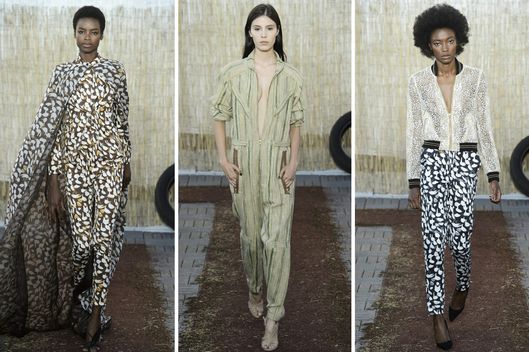
Theallet’s show was on the roof of a West Side parking garage, with half-built luxury apartments and immense blue sky as a backdrop. She, too, is a gifted designer (she trained with Azzedine Alaïa) and a wonderful colorist, but her small business has struggled to gain traction. It’s the woe of many designers without sufficient capital.
But this collection showed her in a brilliant new light. Actually, from the exuberance of the African-inspired clothes, I think Theallet decided she’d had enough of trying to play the conventional game. She was going to design only what she felt in her bones. And that meant flowing chiffon dresses and capes in custom, smudgy leaf prints, a lovely washed-cotton jumpsuit in a broken green stripe pattern, and a delicate bomber jacket, its beadwork like droplets of rain on glass. No one this season in New York has done fabrics in such original textures and patterns. Some evoked a braid or maybe a basket weave; it was difficult to tell because she had successfully blurred the origins.
In its realistic drama, the show was a huge step up for her, and the city’s fashion reputation. Theallet was rewarded with a standing ovation.
To be fair, it was a 13 foot-long dress.
You and Rihanna Will Both Want to Invest in Dior’s New BagIt's got something for everyone.
Polo Shirts Have Turned Their Back on Ryan LochteAlong with his other major sponsors.
Ryan Lochte Will No Longer Be Paid to Wear Tiny Bathing SuitsSpeedo remains committed to transparency.
Laura Brown Is the New Editor-in-Chief of InStyleAfter 11 years at Harper’s Bazaar.
Tyra Banks Is Going to Teach a Class on Smizing at Stanford"If I see somebody not paying attention, I’m gonna call on them."
This Floating Pier Is the Most Zen Installation EverWalking on water in Italy.
Nation Is Appalled by Matt Lauer’s Nude Ankles During Ryan Lochte InterviewWhat’s the opposite of “Jeah”?
8 People at the Life of Pablo Pop-up Explain Why Kanye West Is a God"I mean, Kanye West is just Kanye West. There's not more or less you can say about Kanye West. He's just Mr. West!"
A T-shirt Is EnoughSimplicity, versatility, and cool. What more could you want?
She took a perfect pencil dive off a 30-foot yacht.
American Apparel Is Being Sued by Former WorkersAs the company considers putting itself up for sale.
A Gendered History of the Tailored SuitFrom Marlon Brando to Coco Chanel.
How Zendaya Developed Such Great Style at the Young Age of 19The star's best looks from Disney to now.
Proof That If You’re Chic Enough, a Little Federal Investigation Doesn’t MatterIs this the best they could do?
5,300-Year-Old Mummified Iceman Probably Would’ve Been a Street-Style StarHe had several different looks and was “pretty picky.”
J.Crew Has Identified 226 Shades of PinkEven more than there are shades of gray.
Gigi and Bella Hadid Merch Is Now Somehow a Thing That Is HappeningToday in Hadidiana.
Gird Your Loins for the Return of Yeezy to New York Fashion WeekThe season approaches.
This Indie Brand Had a Great Response to Ivanka TrumpWhen she bought one of their cuffs, they donated the proceeds to the Clinton campaign.